Artist Interviews 2021
Christy Davis Dyer

By Johnny Otto
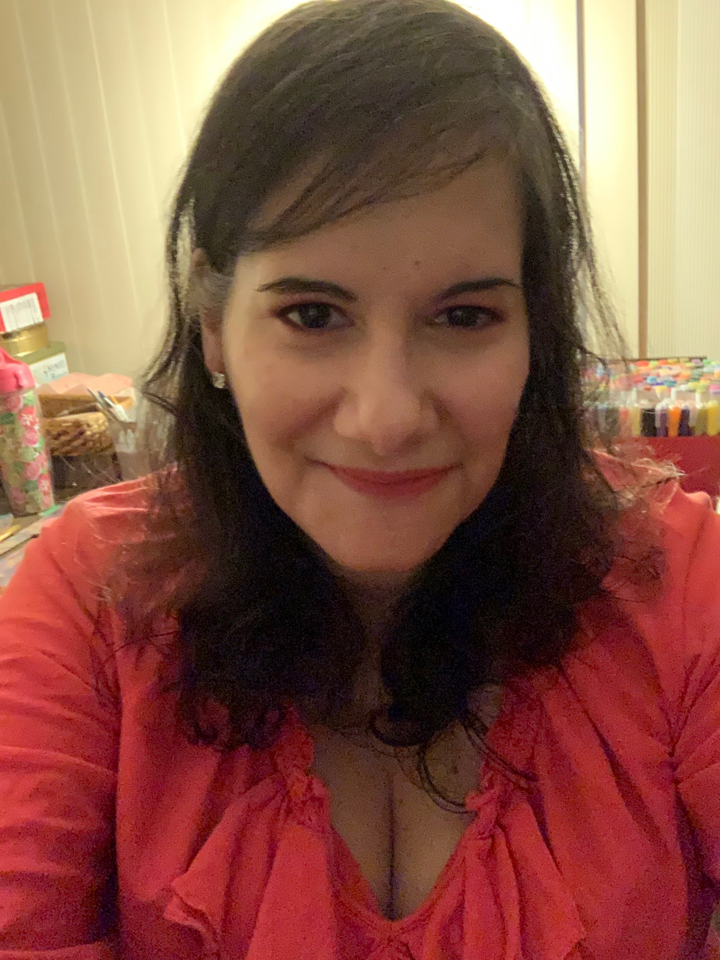
Christy Davis Dyer, a native of Philadelphia, PA, is an emerging abstract expressionist and mixed media artist. One hundred percent self-taught, six weeks of PTSD art therapy was Christy’s introduction to the abstract art world. During therapy, a massive amount of hidden creativity unleashed itself and an artist was born. Since then, Christy has transformed her unbridled and intuitive creativity into passionate works of art imbued with color, symbolism and expressive style. She uses a variety of different mediums in her artwork with a primary emphasis on acrylics, watercolors and oil pastels. Occasionally, non traditional mediums ranging from honey and coffee grounds to salt crystals and hair conditioner are utilized. Her inspiration is drawn from her own life experiences, nature, music and animals. She is also inspired by Klee, Kandinsky, Twombley and Richter as well as the beautiful and imaginative artwork of Kasey Shantz, her dear friend and mentor. According to Christy: “Becoming an artist has been a truly surprising and transformative experience. After months of hard work, dedication and self-reflection, I now know that my true calling in life is as an artist. Art not only saved me but has brought joy, laughter and passion back into my life”.
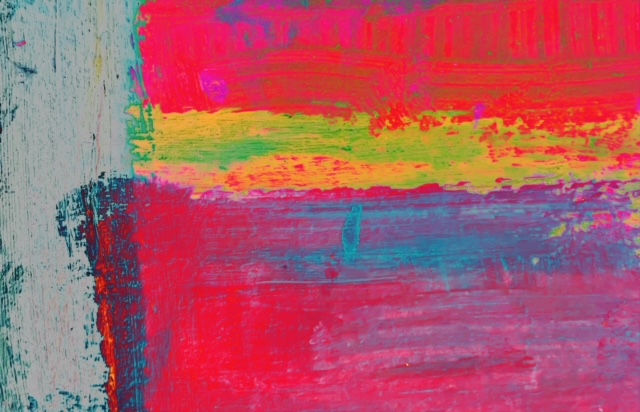
You state that art is therapy for you. Could you tell me how if affects your mood and how you first discovered that it was something that had a profound impact on you?
I suffer from PTSD . Over the last five years, I lost three loved ones, experienced extreme career burnout, was victimized by a cyber stalker, underwent emergency gall bladder surgery and was hospitalized for clinical depression. When people think about PTSD, they think about war veterans or survivors of abuse or natural disasters but according to recent research, PTSD can result from other forms of traumatic experiences. For me personally, the events covering the last five years were so traumatic and stressful that I developed PTSD. I’ve explored many treatments for PTSD and nothing seemed to halt the symptoms of this disorder. That is, until art therapy made an appearance in my life.
Before I started art therapy I did lots of research.According to theArt Therapy Credentials Board, art therapy is beneficial for trauma survivors, stress and anxiety and significant health challenges and health conditions. Art therapy also enhances social skills and improves conflict resolution. So basically art therapy can improve one’s well being. It can also release creativity and promote self-discovery and provide a safe and healthy space to express both conscious and unconscious feelings.
Margaret Naumberg is considered the mother of art therapy. She was influenced by
psychoanalytic theory and believed that during the creative process, individuals are able to uncover unconscious and repressed emotions. This is primarily one of the main reasons I chose art therapy as a therapeutic healing tool and coping mechanism because through the creation of my artwork, I would understand myself better and psychologically heal from the multiple traumas that produced PTSD. During my six weeks of art therapy, a spiritual reawakening occurred and also a transformation. Art therapy unleashed a massive amount of hidden creativity that had existed but hadn’t been previously released.Art therapy not only led to the personal discovery that my true calling in life is as an artist but also helped me begin to heal.Art therapy began my artistic journey.
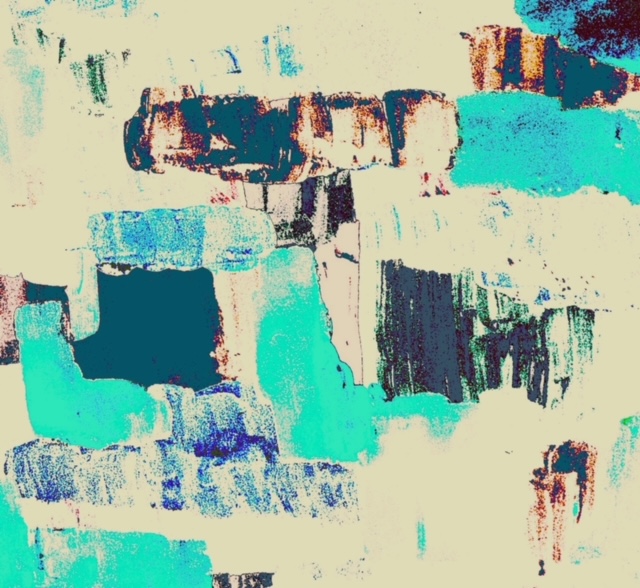
If you hadn’t discovered painting, where do you think you’d be today, spiritually, mentally , emotionally?
If I had not discovered painting, my spiritual, mental and emotional paths are unclear. There is no cure for PTSD but the illness can be managed.
Medication can be utilized for depression and a new career or job can help solve burnout. Being cyber-stalked was the most frightening experience of my life
because not only was it extremely humiliating and demoralizing to be psychologically terrorized by a hacker but it was a personal violation.
I’m still afraid but I’ve learned many useful methods to stay safe on social media. I will never recover from losing three loved ones within two years but I’m trying to
cope in the best way I know how. Painting is helping me heal. If I hadn’t discovered painting, I suspect that I would still be struggling, still stuck in an unsatisfying
career and would still be psychologically unwell. Before I started painting, I tried every treatment method and nothing really worked. One of the problems trauma survivors
face is that sometimes trauma becomes stuck in your body and when that happens your body goes haywire. Before I started painting, my PTSD symptoms were debilitating.
Now my symptoms have significantly lessened. In a way, art has saved my life. Becoming an artist has changed my life so much. I’ve learned to trust myself,
trust my intuition, trust the creative process, reclaim parts of myself that I love, forgiveness, acceptance and strength to let go of things that are beyond my control.
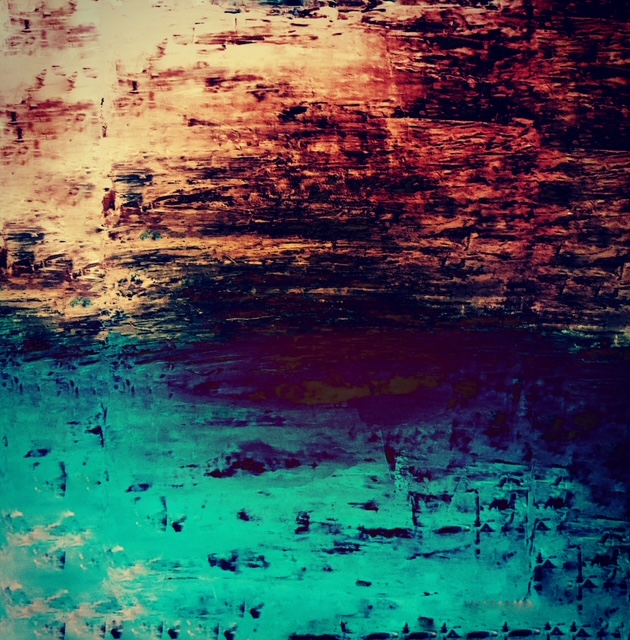
Who or what are your influences and how do they inspire you?
I think joint collaboration among artists is important because every artist has their own strengths and weaknesses. Through collaboration, two artists with like minded vision can work together. Collaboration
improves artistic growth and advances development and for me personally, collaboration may improve some weaknesses I see in my own art. I have not had the opportunity to do a joint
collaboration yet. There are four artists I met on Instagram that I would love to collaborate with. All four are abstract artists and huge sources of inspiration for me and I believe I
could benefit artistically and intellectually from working with them. They would be good teachers and I would learn a lot from them. Plus, just working with them would be such a pleasure and such an honor
because I greatly admire their artistic abilities and their artwork and their work ethics and their attitudes. The four artists are as follows: Sebastian Merk, Kristine Pabst, Sarah Judd and
Scott Alexander
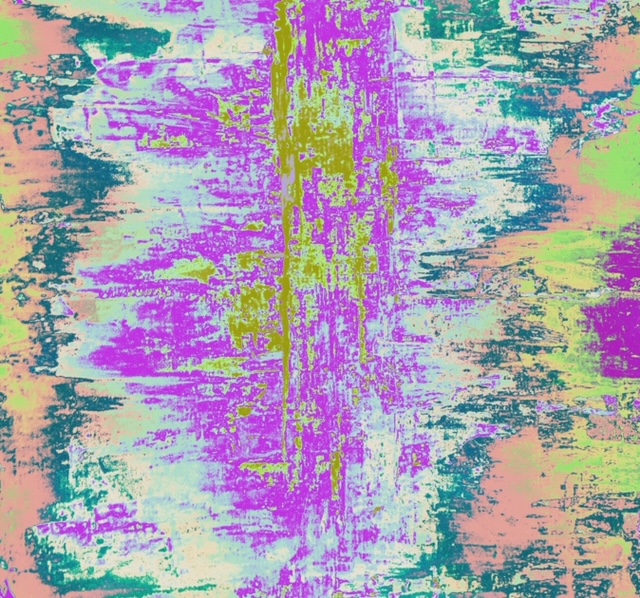
You mentioned that you incorporate coffee grounds, honey and other medium into your work. How did that come about? And what do you think it adds to your work tat pain alone doesn’t accomplish?
When I was a little girl my friends and I used to play a game called Disgusting Food. The purpose of this game would be to create the most disgusting food concoction out of items found in the kitchen pantry or laundry room. I remember mixing ketchup and mustard and salad dressing and orange juice together or shampoo, soup, salt and chopped bananas together and grossing not only my friends but myself and my parents out.Although my concoctions were truly sickening, some of them produced very interesting colors and textures.
One day a few months into my art journey, I was out of red paint and that memory of Disgusting Food came to mind. So I looked into the refrigerator and mixed a small dollop of ketchup and honey together and a few drops of water and used that in place of red paint. It was an interesting addition to my painting. Since then, I’ve occasionally experimented with food or toiletries or even rain water and dirt in my art. I’ve always been very imaginative and very curious and I enjoy painting with non traditional mediums every now and then. After my red paint replacement experiment, I did some research about food in art. In the 1960s, there was a new movement called EatArt where food was used in a variety of ways to create ephemeral art. During the 2012 election, Industry Of The Ordinary (an organization comprised of two artists namedAdam Brooks and Mathew Wilson), hired an artist named Bob Kling to carve a bust of President Obama out of unsalted butter. Montreal-based artist and film director Cosimo Cavallaro created an angel sculpture made from chocolate and another Montreal artist named Shelley Miller created a mural made entirely out of sugar and frosting decorations. There are many other examples I could cite but learning about using food as a medium is fascinating.As I stated above, I occasionally use food in my art to create unusual colors or textures. I use coffee grounds sometimes in my landscapes to give the illusion of a muddy terrain and I sometimes use cherry pie filling to prime my canvas. For some odd reason, the pie filling and paint combined make the colors sparkle and shine. Whenever I’m out of molding paste, I use hair conditioner mixed with Ponds cold cream to create impasto. I know that as I become more experienced, I will learn more painting techniques and be able to utilize them in my art. I enjoy the learning process very much and I also enjoy experimentation. After I master certain techniques, I will probably continue using food from time to time. It’s fun and the food adds a little something extra and different in my paintings.
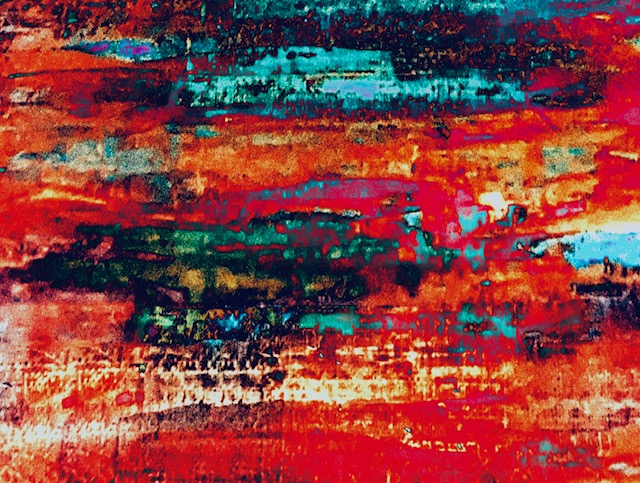
Have you been showing your work or have any shows coming up or is your focus on just creating more art?
My creative process is a mystery to me. My work is mostly intuitive and I can’t explain why I choose the colors I do or why some of my paintings look a certain way. I rarely start painting with an idea. I begin a painting by making lines of color across the canvas and then an idea forms. I have many sources of inspiration. Inspiration is everywhere and I’ve always been very curious and very observant. In my artwork, my inspiration comes from the following: childhood memories, animals, music, my bedroom closet (colors), my jewelry box (shapes), my emotions and nature, particularly water themes. My studio is in my home and it’s quiet and secluded and floor to ceiling windows are on all sides. My desk faces my backyard and during the day, I feast on the beautiful flowers and trees and birds that visit and at night I listen to a conversation between two owls or crickets or the sounds of rain or a good thunderstorm. I’m very attuned to my environment.
There are so many artists I admire, who inspire me and influence me. The expressionist artists who influence me the most are Gerhard Richter, Paul Klee, Mark Rothko and Dusti Bonge. I love Picasso and cubism. I love the wild colors and compositions in Pollock’s work. The de Koonings are another favorite.Alma Thomas influences me the most when it comes to colors. There are so many more that I could name but these are the ones that affect me the most.Also, I am drawn to artists whose works elicit an emotion in me. Art that makes me feel something and speaks to me is good art. I realize that all art is subjective and there is no bad art but when a painting evokes feelings inside me, that is the art that captures my attention. This is one of the elements that I am trying to portray in my own art. I want the viewer to not only look at my art but to feel it too.
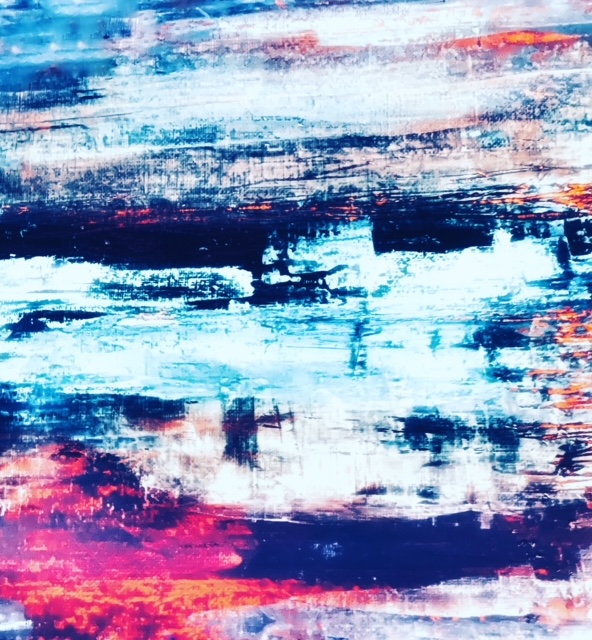
I recently saw the Gerhard Richter show at the Gagosian in Beverly Hills, then immediately discovered your work and felt that there is a similarity in some of your styles. Do you feel a connection to his work? What is is about his work and abstract expressionism in general that is so appealing?
It is hugely flattering when someone tells me that my art has similarities to other artists’ work. Recently an artist noted that he saw similarities in my art to Gerhard Richter’s art and this is probably the best compliment I have received yet because Richter is my favorite artist and his artwork is brilliant. He demonstrates an incredible artistic range, shifting mainly between abstract expressionism and realism. I’m mainly drawn to his non-representational Color Chart paintings, gestural art and landscapes. His painting methods fascinate me. It’s amazing how a spatula or a sponge or a palette knife can create such spectacular designs and colors. What I particularly love about Richter is that I can identify with him based on his creative process. I start paintings the same way with no concrete ideas or visions. I also share his love for experimentation. One day I want to attend one of his exhibits and see his daring and exciting and passionate work up close.
Abstract Expressionism is the style that most resonates with me for a variety of reasons. Leo Tolstoy’s Expression Theory centered on the idea that art provokes and elicits emotions in the viewer. Abstract Expressionism is comprised of various mediums and techniques, all designed to create art in non-traditional and non-representational ways. Strong messages and emotions are expressed within the art using gestural abstraction and colors. I’m attracted to this style of painting for these reasons. I enjoy allowing my feelings and emotions to dictate what I express in art. The images play second fiddle to the artist’s emotions and the viewer’s perception. InAbstract Expressionism, art is spontaneously and subconsciously created and I particularly love that colors are used to represent moods. As I’ve stated before, I’m very intuitive and very in touch with my emotions and I’m also an empath and this ability to feel people’s emotions is hugely beneficial in my artwork.
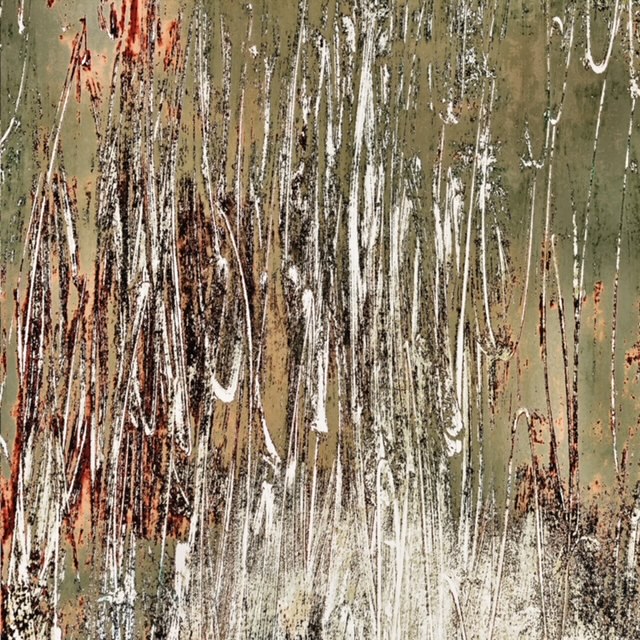
Any artists that you would love to collaborate with and why?
Art therapy was my introduction to the abstract art world and was the first stage of my journey. I am a beginner and I am self-taught. Aside from two art classes in high school, I don’t have prior experience with art. I understand that it takes a lifetime to fully develop your craft. I also understand that there are many aspects that a good artist must learn. Examples would be learning about discipline, how to deal with rejection, success and bruised egos, making connections, understanding the intricacies of the art market and how to successfully market yourself and your art, education, workshops, classes. There are lots of things to learn and I’m at the beginner stage.At some point I would love to show my art. I’ve already experienced a small measure of success. I’ve sold two landscape paintings and a school in London used one of my paintings in a special art exhibit for foundation art students. The students studied the colors and composition of my painting and then each one replicated my painting based on their own interpretation. The very fact that one of my paintings was used as a teaching tool is incredibly moving and flattering and amazing. I’m inexperienced yet my art obviously has an effect on others. So the answer to your question is yes. I want to show my art but I want to be ready first but if an opportunity presents itself, I won’t hesitate to use it.
|
|

